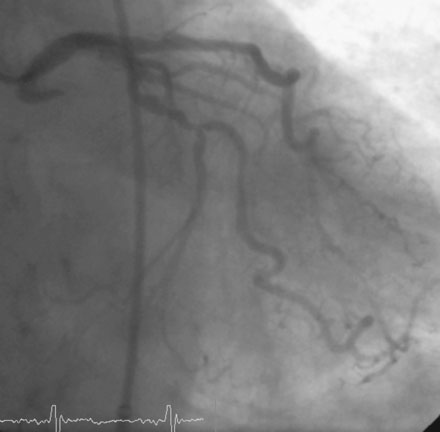CASE 34 Left Main Dissection During Intervention
Cardiac catheterization
Coronary angiographic findings included moderate luminal narrowing in the right coronary artery, no significant obstructive disease of the left anterior descending artery, and severe disease in the circumflex involving the bifurcation of a large obtuse marginal branch (Figure 34-1 and Video 34-1). The operator anticipated difficulty with the proximal tortuosity of the circumflex and, after administration of bivalirudin, used an 8 French left Amplatz 2.0 guide catheter to engage the left coronary artery. Floppy-tipped guidewires were advanced into each branch of the circumflex and balloon angioplasty was performed (Figure 34-2). Following balloon angioplasty, angiography demonstrated persistent narrowing but no other angiographic complications (Video 34-2). The operator encountered difficulty advancing a 2.5 mm diameter by 18 mm sirolimus-eluting stent into the first obtuse marginal and achieved success by pushing the guide catheter deeply into the left main stem. After deploying the stent, angiography uncovered dissection of the left main stem (Figure 34-3 and Video 34-3). Several minutes after this angiogram, another coronary injection displayed dramatic worsening of the left main dissection (Figure 34-4 and Video 34-4) with near closure of the lumen and extensive contrast retention surrounding the left main stem. The patient reported severe chest pain but blood pressure and rhythm remained stable. A 3.5 mm diameter by 18 mm long sirolimus-eluting stent was deployed in the left main stem. This resolved her chest pain, restored luminal patency, and eliminated evidence of contrast retention (Figure 34-5 and Video 34-5).




